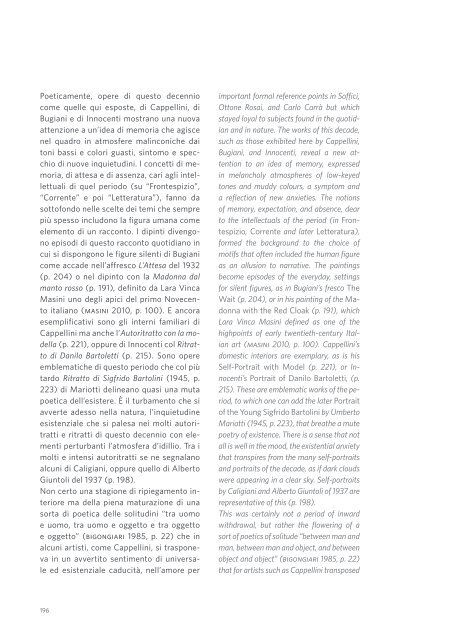Pistoia Novecento 1900 - 1945
a cura di / curated by Annamaria Iacuzzi Philip Rylands
a cura di / curated by
Annamaria Iacuzzi
Philip Rylands
Create successful ePaper yourself
Turn your PDF publications into a flip-book with our unique Google optimized e-Paper software.
Poeticamente, opere di questo decennio<br />
come quelle qui esposte, di Cappellini, di<br />
Bugiani e di Innocenti mostrano una nuova<br />
attenzione a un’idea di memoria che agisce<br />
nel quadro in atmosfere malinconiche dai<br />
toni bassi e colori guasti, sintomo e specchio<br />
di nuove inquietudini. I concetti di memoria,<br />
di attesa e di assenza, cari agli intellettuali<br />
di quel periodo (su “Frontespizio”,<br />
“Corrente” e poi “Letteratura”), fanno da<br />
sottofondo nelle scelte dei temi che sempre<br />
più spesso includono la figura umana come<br />
elemento di un racconto. I dipinti divengono<br />
episodi di questo racconto quotidiano in<br />
cui si dispongono le figure silenti di Bugiani<br />
come accade nell’affresco L’Attesa del 1932<br />
(p. 204) o nel dipinto con la Madonna dal<br />
manto rosso (p. 191), definito da Lara Vinca<br />
Masini uno degli apici del primo <strong>Novecento</strong><br />
italiano (masini 2010, p. 100). E ancora<br />
esemplificativi sono gli interni familiari di<br />
Cappellini ma anche l’Autoritratto con la modella<br />
(p. 221), oppure di Innocenti col Ritratto<br />
di Danilo Bartoletti (p. 215). Sono opere<br />
emblematiche di questo periodo che col più<br />
tardo Ritratto di Sigfrido Bartolini (<strong>1945</strong>, p.<br />
223) di Mariotti delineano quasi una muta<br />
poetica dell’esistere. È il turbamento che si<br />
avverte adesso nella natura, l’inquietudine<br />
esistenziale che si palesa nei molti autoritratti<br />
e ritratti di questo decennio con elementi<br />
perturbanti l’atmosfera d’idillio. Tra i<br />
molti e intensi autoritratti se ne segnalano<br />
alcuni di Caligiani, oppure quello di Alberto<br />
Giuntoli del 1937 (p. 198).<br />
Non certo una stagione di ripiegamento interiore<br />
ma della piena maturazione di una<br />
sorta di poetica delle solitudini “tra uomo<br />
e uomo, tra uomo e oggetto e tra oggetto<br />
e oggetto” (bigongiari 1985, p. 22) che in<br />
alcuni artisti, come Cappellini, si trasponeva<br />
in un avvertito sentimento di universale<br />
ed esistenziale caducità, nell’amore per<br />
important formal reference points in Soffici,<br />
Ottone Rosai, and Carlo Carrà but which<br />
stayed loyal to subjects found in the quotidian<br />
and in nature. The works of this decade,<br />
such as those exhibited here by Cappellini,<br />
Bugiani, and Innocenti, reveal a new attention<br />
to an idea of memory, expressed<br />
in melancholy atmospheres of low-keyed<br />
tones and muddy colours, a symptom and<br />
a reflection of new anxieties. The notions<br />
of memory, expectation, and absence, dear<br />
to the intellectuals of the period (in Frontespizio,<br />
Corrente and later Letteratura),<br />
formed the background to the choice of<br />
motifs that often included the human figure<br />
as an allusion to narrative. The paintings<br />
become episodes of the everyday, settings<br />
for silent figures, as in Bugiani’s fresco The<br />
Wait (p. 204), or in his painting of the Madonna<br />
with the Red Cloak (p. 191), which<br />
Lara Vinca Masini defined as one of the<br />
highpoints of early twentieth-century Italian<br />
art (masini 2010, p. 100). Cappellini’s<br />
domestic interiors are exemplary, as is his<br />
Self-Portrait with Model (p. 221), or Innocenti’s<br />
Portrait of Danilo Bartoletti, (p.<br />
215). These are emblematic works of the period,<br />
to which one can add the later Portrait<br />
of the Young Sigfrido Bartolini by Umberto<br />
Mariotti (<strong>1945</strong>, p. 223), that breathe a mute<br />
poetry of existence. There is a sense that not<br />
all is well in the mood, the existential anxiety<br />
that transpires from the many self-portraits<br />
and portraits of the decade, as if dark clouds<br />
were appearing in a clear sky. Self-portraits<br />
by Caligiani and Alberto Giuntoli of 1937 are<br />
representative of this (p. 198).<br />
This was certainly not a period of inward<br />
withdrawal, but rather the flowering of a<br />
sort of poetics of solitude “between man and<br />
man, between man and object, and between<br />
object and object” (bigongiari 1985, p. 22)<br />
that for artists such as Cappellini transposed<br />
“le cose anormali, vicine a cadere” in cui il<br />
pittore si riconnetteva alla sensibilità dell’amico<br />
Bigongiari, allora più narratore che<br />
poeta (Bigongiari, lettera a Ciattini del 13<br />
novembre 1933, cit. in iacuzzi-dei 1985, p.<br />
37). Con Bigongiari, presente a <strong>Pistoia</strong> fino<br />
al 1937 ma in contatto anche in seguito,<br />
Cappellini condivideva momenti di pittura<br />
nella campagna in passeggiate dal sapore<br />
iniziatico, spesso ricordate dal futuro poeta<br />
(bigongiari 1985).<br />
Tra le opere di questo decennio, esposte<br />
nel nuovo allestimento, tra lavori di artisti<br />
che negli anni Trenta sono una conferma, ci<br />
PIETRO BUGIANI<br />
Il mulino della Bure, s.d., acquaforte su zinco<br />
The Mill of the Bure, n.d., zinc etching<br />
Fondazione Caript, <strong>Pistoia</strong>, n. inv. 692/10<br />
itself into a conscious feeling of universal<br />
and existential transience, into a love for<br />
the “abnormal things, about to fall” in line<br />
with the sensibility of his friend Bigongiari,<br />
at that time more a storyteller than a poet<br />
(Bigongiari, Letter to Ciattini 13 November<br />
1933, quoted in iacuzzi-dei 1985, p. 37).<br />
Cappellini shared with Bigongiari – who<br />
was in <strong>Pistoia</strong> until 1937, and who stayed in<br />
touch even after – moments when he would<br />
paint the countryside during walks together,<br />
that had something of the initiatory about<br />
them, and which the future poet would often<br />
recall (bigongiari 1985).<br />
196 197













